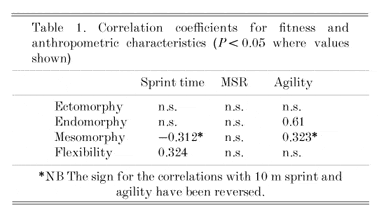During a competitive soccer season, young players are subjected to physical exertion during both training sessions and matches. A combination of this physical exertion and increases in strength due to maturation may result in changes in physical fitness (Armstrong & Welsman, 1997). The aim of this study was to investigate changes in physical fitness in elite youth team soccer players over a competitive season.
Fourteen boys, aged 11-12 years were recruited from the soccer academy of a nationwide league side. Fitness, as predicted by sprint times over 10 m, performance during the multistage shuttle run (MSR), agility (measured by a run through cones), and hamstring flexibility (sit and reach test) were monitored at 7 week intervals over the complete soccer season. Somatotype was calculated using the Heath & Carter (1967) method.
Linear regression coefficients (LRCs) for each measured parameter were calculated and one-tailed t tests used to detect any significant changes in the LRCs over the season. Pearson’s correlation coefficients were calculated to test the relationships between parameters.
Over the season there were significant increases in the LRCs for height, weight endomorphy and mesomorphy, accompanied by significant decrease in ectomorphy (P < 0.05) with no overall change in body fat. Fitness improved as measured by time taken to complete the agility run (P < 0.05) but decreased as indicated by increased time taken for the sprint. Hamstring flexibility and MSR performance showed no significant change.
The significant negative correlation between both weight and mesomorphic characteristics with sprint times could explain this decrease in performance.
The Chester College ethics committee provided ethical approval.

